Front and Center Vol. 2 No 7 July 2023

FRONT AND CENTER
Vol. 2, No 7, July, 2023
Mission
Honoring the legacy of Carolina Marines and Sailors and inspiring future generations.
Message from the SE0
It has been said that “Everything good, everything magical happens between the months of June and August”. This applies to the Museum as well!
We are aggressively working all pre-construction activities and rapidly approaching completion of “concept development” for the exhibits. We will share these details with you next month, but RAA (our exhibit designer) continues to impress.
We continue to press on all fronts to get the lease approved. With the Assistant Commandant’s nomination to become Commandant, the review has been slightly delayed, but we remain confident that a decision is on the horizon.
For all those that supported our annual golf tournament, we thank you. It was a “wet” event, but also very successful. We are blessed to have such a wonderful community of supporters. You can’t touch it, but you can feel it and it is special.
Lastly, we celebrated General Gray’s 95th birthday in June, we are forever grateful for his leadership and commitment to our mission.

Semper Fi,

BGen Kevin Stewart, USMC (Ret)
Chief Executive Officer
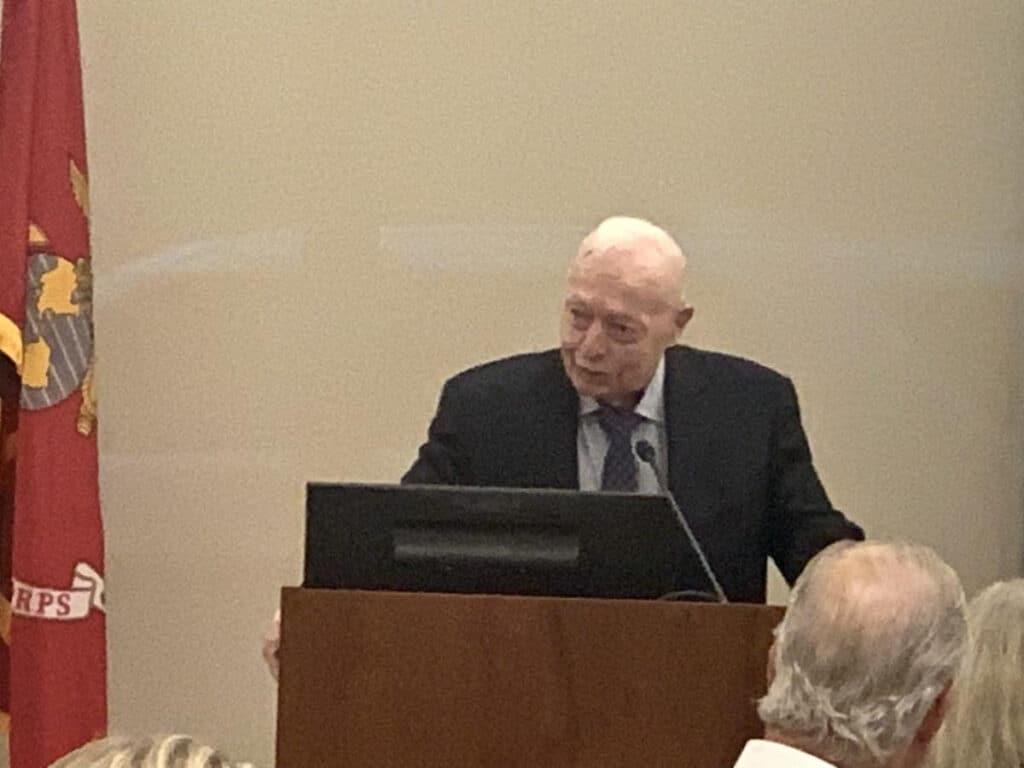
General Al Gray, 29th Commandant of the United States Marine Corps, addresses more than 300 people who came to wish him a happy 95th birthday.
Situation Report
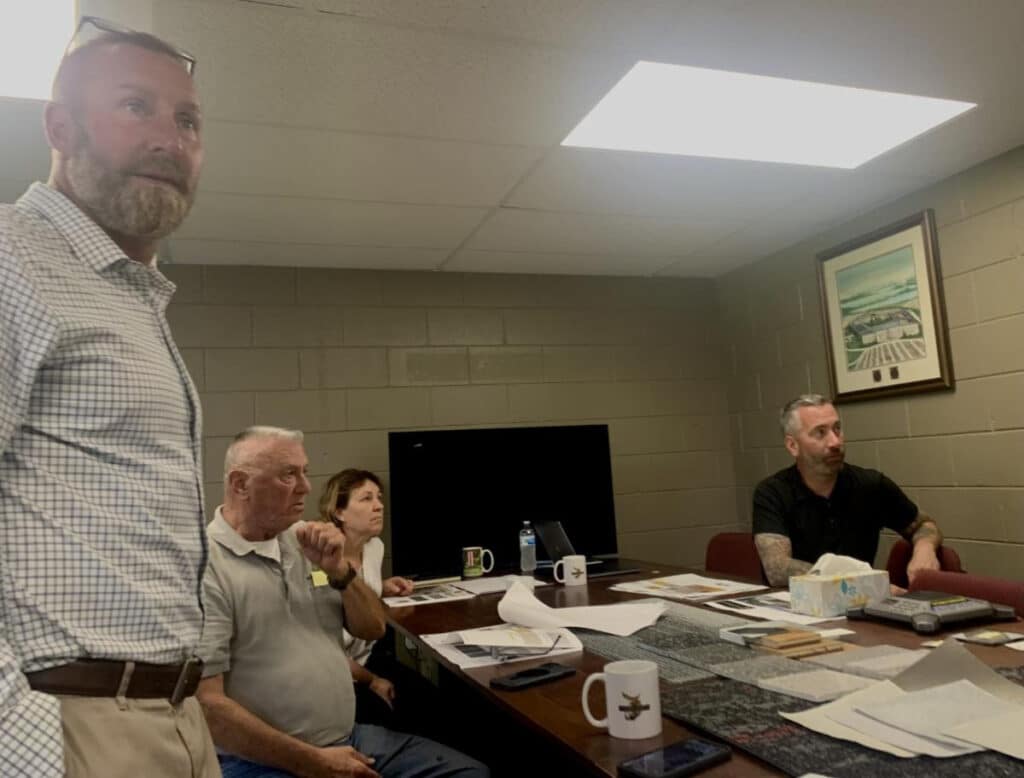
Our team hosted CJMW architect John Drinkard and Keagan Pope along with
Ralph Appelbaum Associates’ Matt Krupanski, Mary Beth Byrne, and Lily Remmert in Jacksonville, NC on the 13th and 14th of June. Two action-packed days reviewing exhibit design concepts, materials and finishes.
Dick Koeckert:
17 Years of Service to Carolina Museum of the Marine
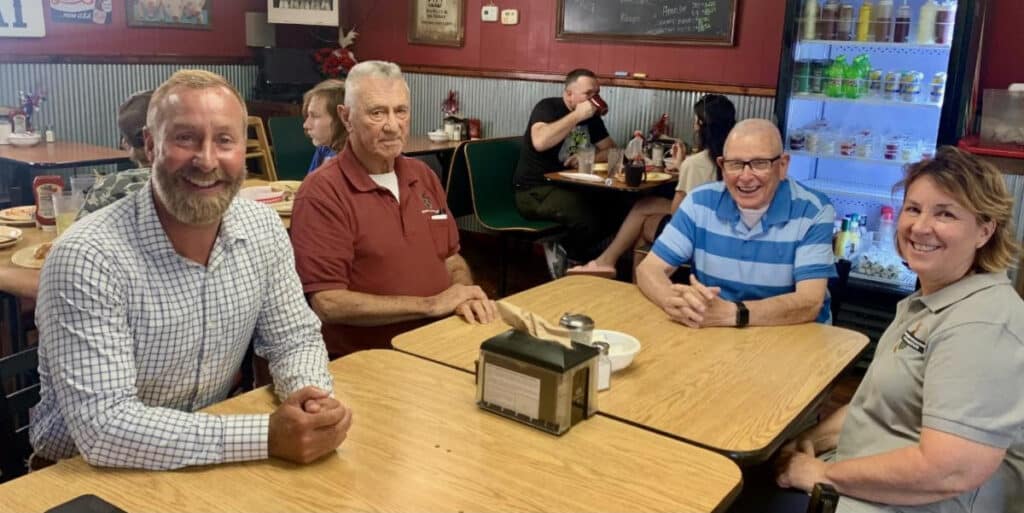
Our team hosted CJMW architect John Drinkard and Keagan Pope along with
Ralph Appelbaum Associates’ Matt Krupanski, Mary Beth Byrne, and Lily Remmert in Jacksonville, NC on the 13th and 14th of June. Two action-packed days reviewing exhibit design concepts, materials and finishes.
If you have been around Carolina Museum of the Marine for any time at all, you’ve met Army veteran Dick Koeckert whose 17th anniversary with us, unfortunately, coincides with his retirement. Our small team took Dick to lunch on 26 June to celebrate his last day. Pictured left to right, CEO BGen Kevin Stewart, USMC (Ret); Director of Operations SgtMaj Joe Houle, USMC (Ret); Finance Manager Dick Koeckert; and Curator CWO5 Lisa Potts, USMC (Ret). Taking the photo: VP of Development Ashley Danielson.
Dick not only served as our finance manager for 17 years but oversaw the entire tribute bricks program, including their installation at Reflection and Celebration Park, Lejeune Memorial Gardens.
To say that we love and respect Dick Koeckert and his lovely bride Annabelle would be an understatement. We are family and while we will miss you, Dick, we are always here and always ready to welcome you back. Semper Fidelis!
Interview with Carolina Marines and Sailors
A Conversation with Senior Chief Joe Speranza, USN (Ret)
Al Gray Marine Leadership Forum Essays
The intent of these essays is to create civil discourse and spur thought. In line with our mantra of “teaching how to think, not what to think” these essays are complex, and the issues addressed are difficult to navigate without sparking some disagreements.
We welcome this, as we work to inspire principled and committed leaders.
A Tale of Two Doctrines, Part II
by James Danielson, PhD
USMC Veteran
In the last issue of “Front and Center,” we introduced the two understandings of political order that comprise the general structure of American political history. The earlier political order, which may be called “Jeffersonian,” lasted from 1776 to 1861. The later political order, which may be called “Lincolnian,” was firmly in place in 1865 and is with us today. In fact, it is this understanding of American government that we were taught as children in school, and it is this form of political order that is at present under pressure from many directions. The purpose of this essay and the one just before it is to describe Jeffersonian and Lincolnian political order and to indicate how the latter developed within the former and finally displaced it. In doing this, our primary focus will be on a series of exchanges among three senators in 1829 and 1830 that have come to be known as the Webster-Hayne debates.
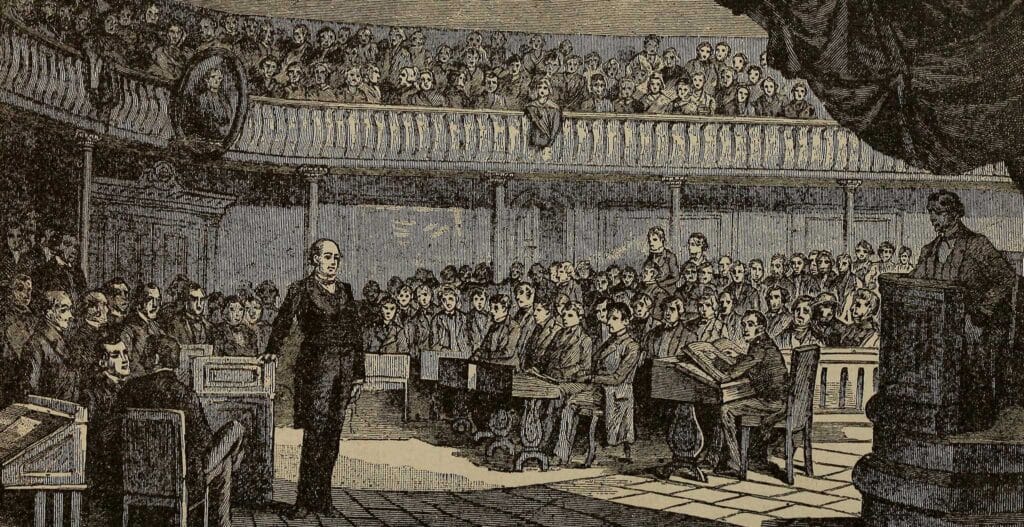
https://archive.org/details/politicalhistory00boyd/mode/1up?view=theater
In earlier writings of the Al Gray Marine Leadership Forum at Carolina Museum of the Marine, we have discussed the Treaty of Paris of 1783 in which the British crown acknowledged the independence of the former colonies of British America. Article I of the treaty opens with these words: “His Britannic Majesty acknowledges the said United States, viz., New Hampshire, Massachusetts Bay, Rhode Island and Providence Plantations, Connecticut, New York, New Jersey, Pennsylvania, Delaware, Maryland, Virginia, North Carolina, South Carolina, and Georgia, to be free sovereign and independent States;…” Note that each state is recognized by name as a free sovereign and independent state. The states were bound together in a federal union for the purposes of mutual security and defense and to maintain the United States internally as a free-trade zone. So the name “United States” was not the name of a unitary national state comprised of one people called Americans, but of a union of sovereign states united for limited and specified purposes. This union was populated by people called New Yorkers, Virginians, North Carolinians, and so on. At this point, a reader may reasonably wonder about the opening words of the preamble to the Constitution, “We the People of the United States,…” that are said to identify Americans as one national people. The confusion here is part of the tale of two doctrines under discussion.
In 1812, President James Madison nominated Joseph Story of Massachusetts to be an associate justice of the Supreme Court. In 1833, Justice Story published a three-volume work titled Commentaries on the Constitution of the United States. What is remarkable about this study is that in it, Story interprets the Constitution as having established a unitary national state rather than the federation of sovereign states ratified by Americans in 1788/89. Story’s commentaries appeared a few years after the Webster-Hayne debates and is part of what was a movement of growing intensity to change how Americans understood their governing order. To be sure, the understanding of government being advanced by Daniel Webster, Joseph Story, Chief Justice John Marshall and others had its adherents from the beginning of the country, but at this time, those whom we may call nationalists were planning to establish their vision of a unitary national state, displacing the federation of sovereign states that the United States were at that time.
Story claims that the words in the preamble to the Constitution announcing that We the People of the United States are establishing a new Constitution is a proclamation issuing from a single people, a nation, Americans all, taken in the aggregate, from north to south, and not a proclamation from an “assemblage of nations.” Thus Story will assert that the union is older than the states, that the People, in union, created the states, and therefore the states are but local governing districts within the union, rather like counties, with no sovereignty of their own. We believe with confidence, however, that Story’s tale is wrong on two closely related counts: there is no documentary evidence for it; and, all documentary evidence that exists establishes the opposite case, namely, that the United States were from their inception a federation of free sovereign and independent states. [i]
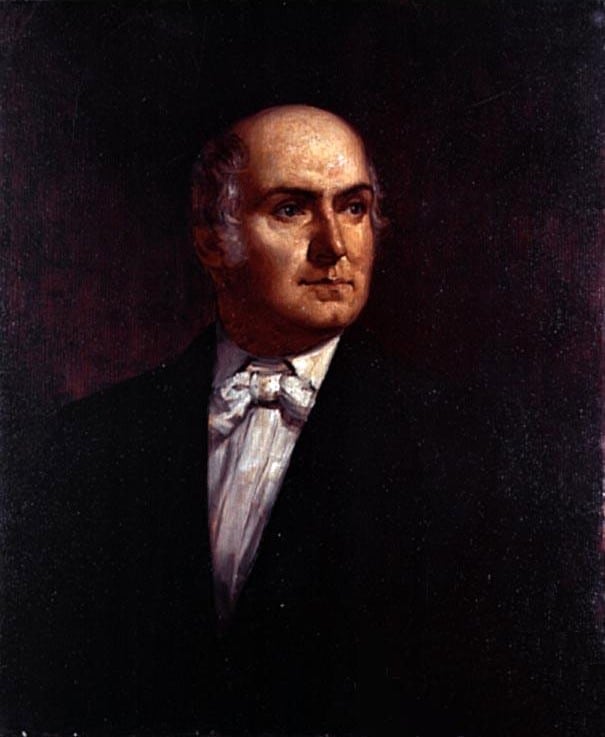
In 1840, Virginia jurist, secretary of the Navy, and secretary of state Abel Upshur published a reply to Justice Story’s commentaries with the cumbersome title A Brief Inquiry into the Nature and Character of Our Federal Government: Being a Review of Judge Story’s Commentaries on the Constitution of the United States. Upshur writes about the wording of the preamble to the Constitution saying that in the preamble to the final version of the document approved by the delegates at Philadelphia, each state was named individually, just as in the Treaty of Paris and in the Articles of Confederation.
Having approved a finished Constitution, the delegates appointed a committee on style, headed by Gouverneur Morris of New York, to render the language of the text more elegant. When that version of the Constitution was returned to the whole body, the delegates went through it line-by-line to ensure that no content inadvertently had been changed. When reading Article VII of the Constitution, the delegates noticed a difficulty they had previously missed. The first sentence of this short Article says: “The Ratification of the Conventions of nine States, shall be sufficient for the Establishment of this Constitution between the States so Ratifying the same.”
There were thirteen states in 1788, and so it would be embarrassing, at least, if four states rejected the Constitution but yet were named in the preamble as though they had adopted it. So the delegates replaced the list of states with a familiar formula referring to the people of the United States. The argument here is that Story distorted the meaning of the preamble to the Constitution in order to advance a nationalist understanding of the government that is not actually in the Constitution. Importantly, we see in the argument of Joseph Story of Massachusetts and in the reply of Abel Upshur of Virginia the continuation of a debate on the nature of the political order established in our Constitution that breaks into view in the Senate in the Webster-Hayne debates of 1830.[ii]
13th Annual “Amphibious” Golf Classic:

We are pleased to say that, despite the rain, our 13th Annual Golf Classic was a tremendous success. We thank everyone who supported this event with undaunted camaraderie. Thank you to Golf Committee Chair, Tom DeSanctis, and good folks at ![]() Bear Trail Golf Club who always treat you right!
Bear Trail Golf Club who always treat you right!
Marines Making News…

Visit Marines.mil for up-do-date information about United States Marines who are making news.
Please join us in supporting the mission of
Carolina Museum of the Marine.
When you give to our annual campaign, you help to ensure that operations continue during construction and when the doors open!
Stand with us
as we stand up the Museum!
Copyright July, 2023
Carolina Museum of the Marine
2022-2023 Board of Directors
Executive Committee
LtGen Gary S. McKissock, USMC (Ret) – Chair
Col Bob Love, USMC (Ret) – Vice Chair
CAPT Pat Alford, USN (Ret) – Treasurer
Col Joe Atkins, USAF (Ret) – Secretary
Mr. Mark Cramer, JD – Immediate Past Chair
General Al Gray, USMC (Ret), 29th Commandant – At-Large Member
LtGen Mark Faulkner, USMC (Ret) – At-Large Member
Col Grant Sparks, USMC (Ret) – At Large Member
Members
Mr. Keith Byrd, US Marine Corps Veteran
Mr. Tom DeSanctis
MGySgt Osceola Elliss, USMC (Ret)
Col Chuck Geiger, USMC (Ret)
Col Bruce Gombar, USMC (Ret)
LtCol Lynn “Kim” Kimball, USMC (Ret)
CWO4 Richard McIntosh, USMC (Ret)
CWO5 Lisa Potts, USMC (Ret)
Col John B. Sollis, USMC (Ret)
GySgt Forest Spencer, USMC (Ret)
Staff
BGen Kevin Stewart, USMC (Ret), Chief Executive Officer
Ashley Danielson, VP of Development
SgtMaj Joe Houle, USMC (Ret), Operations and Artifacts Director
Richard Koeckert, Accounting Manager
Carolina Museum of the Marine is a nonprofit organization that is rigorously nonpartisan, independent and objective.

